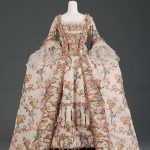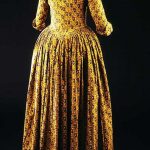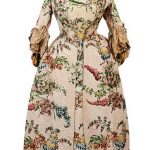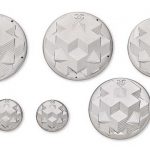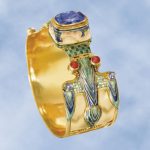Fashionable 18th century dresses were usually French, mainly due to the prestige of the Court of Versailles which had occurred during the last twenty years of the 17th century. However, Versailles was no longer the Court of a young King but of an aging monarch whose thoughts were turning to piety and this led to dresses having more rigid lines than in the previous century.
After the death of Louis XIV in 1715, a new fashion arose. Dresses became looser with more flowing lines. The new form of dress was called a “sack” or “sacque” which was a comfortable but rather shapeless garment with small box pleats behind. This period also saw a return of hoops. Instead of height ladies now seemed to aim at width, and the skirt was extended sideways by means of whalebone or rods of osier.
Robes could either be open, showing elaborate petticoats underneath or closed which consisted of a bodice and petticoat, often forming one garment and with no opening at the front. Bodices also had a gap in front filled in by means of a stomacher shaped like a shield and stiffened with pasteboard or busks. Sleeves ended just above or just below the elbow.
By the beginning of the 1770’s, there was a marked change in the general outline of women’s dress which can be summed up as a transition from hoops to a kind of bustle. The bodice also began to be puffed out.
Below are some examples of dresses from the 18th century. Reference: [geolocator_show for=”GB”]A Concise History of Costume by James Laver[/geolocator_show]
[geolocator_hide for=”GB”]A Concise History of Costume by James Laver[/geolocator_hide]
Woman’s dress French about 1770 Object Place: France
White silk rep brocaded with polychrome silk in scrolling floral sprays and baskets; trim of silk thread tied in rosette bows. Overdress: trimmed, pleated panels along front line; short, fitted sleeves with trimmed, double asymmetrical dagged ruffles; sack (Watteau) back; wide flat panier accomodating skirt with slits off hip line; linen liner gathered with tapes at back. Underskirt (matching except white brocaded floral silk at upper rear): fullness controlled by draw tapes at far sides, two small pleats at front; two horizontal bands of trimmed box pleats at front base; cotton or linen and silk linings at base. Stomacher with horizontal bands of trim, cotton lining.
Reference: Museum of Fine Arts Boston
Dress of block-printed cotton in ochre. The design is of floral sprigs in small lattice on green and yellow ground. The gown has a close fronted bodice, an open fronted skirt and an English back. The sleeves have a small turn back cuff. The bodice is lined with linen.
Object Type The style of this gown reflects the transitional nature of early 1780s dress. The elbow-length sleeve and pointed waist are typical of the 1770s, while the front-closing bodice and stitched pleats at the back look forward to the new fashions of the 1780s.
Ownership & Use This gown represents an informal style for a wealthy woman, and was known as a morning gown. The darker colours were appropriate for a winter gown. A petticoat, possibly a quilted one, would have been worn underneath and shown at the opening of the gown in front.
Social Class While appropriate as informal dress for a woman of means, this gown might also have acted as ‘Sunday best’ for a working-class woman. The mechanisation of the spinning of cotton reduced the cost of the fabric. Distributing the material through regional retailers and travelling pedlars meant that new designs were available throughout the country and affordable by all but the destitute.
Design & Designing The vibrant hues of this printed English cotton demonstrate a variation from the light palette of Neo-classical dress. A repeating pattern of floral sprigs within brown leaf trails has been printed in ochre, madder and green. The blue thread in the selvedge of the fabric indicates that it was made in England, most probably Manchester.
Reference: © Victoria and Albert Museum
A mid 18th century floral silk brocade dress, remodelled in the 19th century The brocade featuring bold floral and peacock feather designs, the dress of sack-back style, the elbow-length sleeves with double frills trimmed with 18th century needlelace, a matching brocade petticoat and attached stomacher. (2)
Sold for £ 1,625 inc. premium at Bonham’s in 2015
[geolocator_show for=”GB”][ebayfeedsforwordpress feed=”http://rest.ebay.com/epn/v1/find/item.rss?keyword=18th+century+dress&categoryId1=175759&sortOrder=BestMatch&programid=15&campaignid=5338620288&toolid=10039&customid=pastimefashions-rss-uk-18th-century-dresses&minPrice=50.0&listingType1=All&feedType=rss&lgeo=1″ items=”20″][/geolocator_show]
[geolocator_hide for=”GB”][ebayfeedsforwordpress feed=”http://rest.ebay.com/epn/v1/find/item.rss?keyword=18th+century+dress&categoryId1=175759&sortOrder=BestMatch&programid=1&campaignid=5338620289&toolid=10039&customid=pastimefashions-rss-us-18th-century-dresses&minPrice=50.0&listingType1=All&feedType=rss&lgeo=1″ items=”20″][/geolocator_hide]
